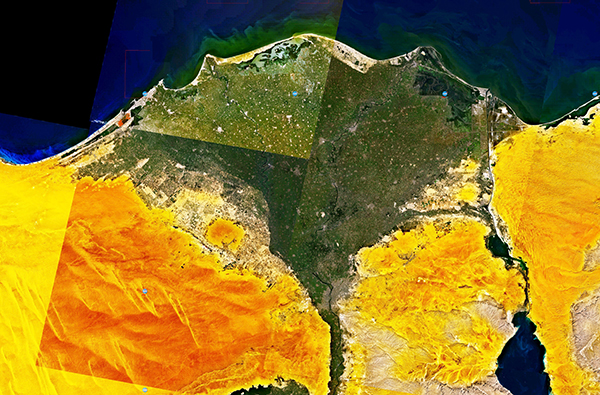
by Lauren Milideo Wednesday, September 25, 2013

Landsat 7 view of the delta of the Nile River where it empties into the Mediterranean. NASA
Sea-level rise due to melting ice is a common worry in coastal areas. But the sea-level story is much more complicated: What lies below the surface — sediment, and the rate at which it compacts — is also an important consideration, especially in deltas.
In a new study, researchers exploring the role of subsurface sediment compaction in coastal subsidence along Egypt’s Nile Delta, most of which lies just a meter above sea level, found subsidence rates there are four times greater than the rate of sea-level rise.
Taking into account predicted rates of sea-level rise in the Mediterranean, as well as the recent decrease in delta-building sediment being delivered by the Nile, the authors predict a significant amount of the Nile Delta — a vulnerable region that is a resource to millions of people — could be submerged within about 130 years.
“We hear mostly about sea-level rise,” says Jean-Daniel Stanley, senior scientist emeritus at the Smithsonian Institution’s National Museum of Natural History and lead author of the study in the Journal of Coastal Research. “You may not hear much about compaction, or subsidence,” but the two work together in coastal zones.
The study “is very interesting because it focuses on a phenomenon often underestimated: the compaction of sediments,” says Maria Rosaria Senatore, an associate professor of geology, stratigraphy and sedimentology at the University of Sannio in Benevento, Italy. “This shows that in about one century a large part of the coastal zone of the Nile Delta will be submerged,” adds Senatore, who was not involved in the study.
The authors studied 85 sediment cores, each 10 to 50 meters long, from across Egypt’s Nile Delta, examining thicknesses of more than 3,000 strata. The team measured stratal thicknesses using scaled digital photographs of each core, and focused on oxidized layers because these were widespread and provided readily identifiable samples of the overall strata. The team calculated average thicknesses of oxidized layers for the northeast, north-central, and northwest portions of their study area, and obtained 300 radiocarbon dates. After establishing an age of about 7,500 years for the basal Holocene section, they used each stratum’s position, between top and baseline, to assign its age.
These data were used to create regression curves of decreasing layer thickness through time, from which compaction rates of different portions of the sediment cores were calculated. Stanley and his colleagues found that sediment compaction, though fastest at the top, continued throughout the core. Compaction is “not something that just occurs near the top of the core,” Stanley notes. Rather, sediments “keep getting [compressed] after this initial rapid rate, maybe during the first thousand or so years,” while lower deposits continue to experience a slower rate of compression, he says. This study offers a means “of measuring the total compaction of each core site.”
Lack of sediment input is another key factor in this region’s future, as the once sediment-laden Nile no longer delivers enough raw material to build and maintain its delta.
“The delta has been entirely crisscrossed by canals, and most of the water that goes north of Cairo … is diverted across the Nile Delta by canals,” Stanley says. And the river "is bringing a very small proportion of the sediments it used to bring into the delta."
Thus, he says, identifying future risks of sea-level rise requires understanding subsurface sediment compaction rates, especially in flat, low-lying regions around the world like the Nile Delta.
The researchers look forward to “expanding to other deltaic areas,” Stanley says. A good place to turn for future research is the Brahmaputra Delta, which, like the Nile, also has “a high population, highly dependent on its delta,” and is likely to be adversely affected by floods and other disasters, he says. When such disasters force part of the population to relocate in countries that are already densely populated, Stanley points out, “there’s no room for the people to go anywhere.”
© 2008-2021. All rights reserved. Any copying, redistribution or retransmission of any of the contents of this service without the expressed written permission of the American Geosciences Institute is expressly prohibited. Click here for all copyright requests.